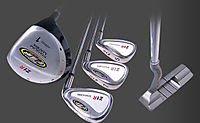Golf Tips and Tricks- Improving Your Grip

The placement of your hands on the golf club believe it or not has a lot to do with your golf game. Holding the club can vastly improve your game providing you follow these tips. You will notice a difference.
The first basic understanding is that the hand placement on the club guide the ball. If you have your hands all over the place then the club will guide the ball in the same manner.
There are two types of grips, the light grip and the firm grip. If you grip the club too tight it will cause the ball to slice. The lighter grip makes for easier wrist movement. You have heard the expression before, it is all in the wrist and in the game of golf it happens to be true. In addition to the light grip of the club, you will begin to the feel your arms and hands become more relaxed.
By positioning the club correctly with the light pressure grip, it can help you control the clubs position on impact. When you turn your body as you swing, the club moves at the same time. The body and the club must turn together; it must be a smooth swing. The wrist movement in the swing is the power of the game.
If you begin by placing the club more in the fingers than the palms of your hand you will notice more of an increase in your wrist movement and that can result in longer shots. That is one known mistake to golfers; they place the club more in the lead hand palm than the do in the fingers. By doing that the drive lacks power and the ball will slice.
Your trailing or bottom hand is the stronger hand for most golfers. For example, if you are right handed the bottom hand will be your right hand. This hand should be positioned to extract a powerful drive without over powering your lead hand. Your hands should be placed in equal formation. That is what makes a great player great. The swing of the club at a consistent rate combined with your balance will improve anyones game.
The problem of some players is that the rush the swing. When you do this you lose your balance the ball will not drive properly. If you watch the professionals play, they make their swing and grips look so easy. The swing the club smoothly and they hit the ball hard. Balance is the key; if you have a good relaxed grip and keep your balance you should notice a huge improvement in your game.
These things don't happen over night so be patient and with a lot of practice you will notice an improvement. Practice at a driving range so you can see how you are driving the ball. Concentrate and follow through and remember it is all in the wrist.
Source





